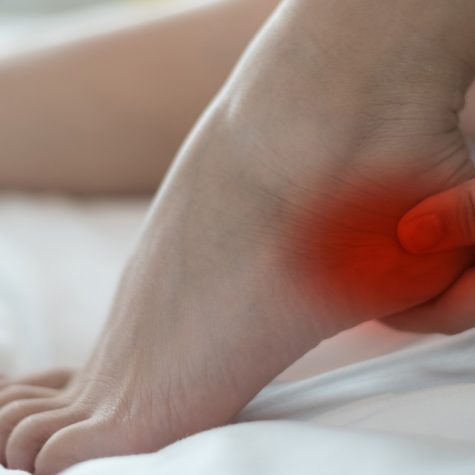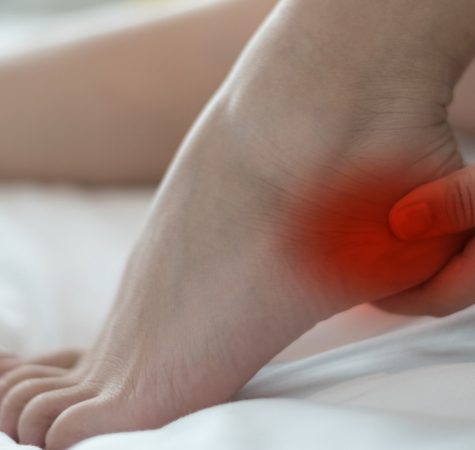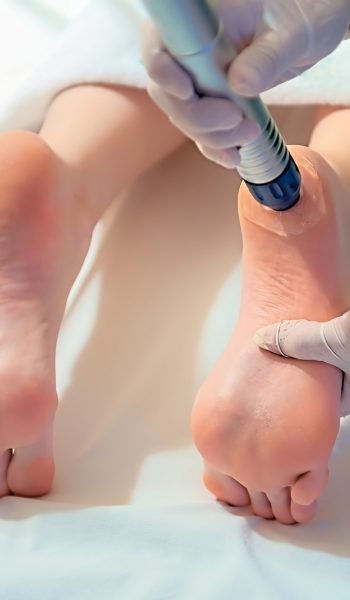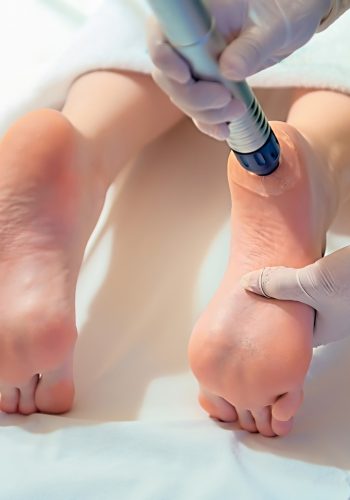What are Heel Spurs?
A common cause of heel pain is the heel spur, a bony growth on the underside of the heel bone. The spur, visible by X-ray, appears as a protrusion that can extend forward as much as half an inch. When there is no indication of bone enlargement, the condition is sometimes referred to as “heel spur syndrome.”
Heel spurs result from strain on the muscles and ligaments of the foot, by stretching of the long band of tissue that connects the heel and the ball of the foot, and by repeated tearing away of the lining or membrane that covers the heel bone.
These conditions may result from biomechanical imbalance, running or jogging, improperly fitted or excessively worn shoes, or obesity. Pain, such as may occur in our heels, also alerts us to seek medical attention. This alert is of utmost importance because of the many afflictions that contribute to heel pain.

What are Heel Spurs?
A common cause of heel pain is the heel spur, a bony growth on the underside of the heel bone. The spur, visible by X-ray, appears as a protrusion that can extend forward as much as half an inch. When there is no indication of bone enlargement, the condition is sometimes referred to as “heel spur syndrome.”
Heel spurs result from strain on the muscles and ligaments of the foot, by stretching of the long band of tissue that connects the heel and the ball of the foot, and by repeated tearing away of the lining or membrane that covers the heel bone.
These conditions may result from biomechanical imbalance, running or jogging, improperly fitted or excessively worn shoes, or obesity. Pain, such as may occur in our heels, also alerts us to seek medical attention. This alert is of utmost importance because of the many afflictions that contribute to heel pain.

Prevention
A variety of steps can be taken to avoid heel pain and accompanying afflictions:
- Wear shoes that fit well — front, back, and sides — and have shock-absorbent soles, rigid shanks, and supportive heel counters.
- Wear the proper shoes for each activity.
- Do not wear shoes with excessive wear on heels or soles.
- Prepare properly before exercising. Warm-up and do stretching exercises before and after running.
- Pace yourself when you participate in athletic activities.
- Don’t underestimate your body’s need for rest and good nutrition.
- If obese, lose weight.
Podiatric Medical Care
If pain and other symptoms of inflammation—redness, swelling, heat—persist, you should limit normal daily activities and contact a doctor of podiatric medicine.
The podiatric physician will examine the area and may perform diagnostic X-rays to rule out problems of the bone.
Early treatment might involve oral or injectable anti-inflammatory medication, exercise and shoe recommendations, taping or strapping, or the use of shoe inserts or orthotic devices. Taping or strapping supports the foot, placing stressed muscles and tendons in a physiologically restful state. Physical therapy may be used in conjunction with such treatments.
A functional orthotic device may be prescribed for correcting biomechanical imbalance, controlling excessive pronation, and supporting the ligaments and tendons attaching to the heel bone. It will effectively treat the majority of heel and arch pain without the need for surgery.
Only a relatively few cases of heel pain require more advanced treatments or surgery. If surgery is necessary, it may involve the release of the plantar fascia, removal of a spur, removal of a bursa, or removal of a neuroma or other soft-tissue growth.
Prevention
A variety of steps can be taken to avoid heel pain and accompanying afflictions:
- Wear shoes that fit well — front, back, and sides — and have shock-absorbent soles, rigid shanks, and supportive heel counters.
- Wear the proper shoes for each activity.
- Do not wear shoes with excessive wear on heels or soles.
- Prepare properly before exercising. Warm-up and do stretching exercises before and after running.
- Pace yourself when you participate in athletic activities.
- Don’t underestimate your body’s need for rest and good nutrition.
- If obese, lose weight.
Podiatric Medical Care
If pain and other symptoms of inflammation—redness, swelling, heat—persist, you should limit normal daily activities and contact a doctor of podiatric medicine.
The podiatric physician will examine the area and may perform diagnostic X-rays to rule out problems of the bone.
Early treatment might involve oral or injectable anti-inflammatory medication, exercise and shoe recommendations, taping or strapping, or the use of shoe inserts or orthotic devices. Taping or strapping supports the foot, placing stressed muscles and tendons in a physiologically restful state. Physical therapy may be used in conjunction with such treatments.
A functional orthotic device may be prescribed for correcting biomechanical imbalance, controlling excessive pronation, and supporting the ligaments and tendons attaching to the heel bone. It will effectively treat the majority of heel and arch pain without the need for surgery.
Only a relatively few cases of heel pain require more advanced treatments or surgery. If surgery is necessary, it may involve the release of the plantar fascia, removal of a spur, removal of a bursa, or removal of a neuroma or other soft-tissue growth.

Heel Spurs Tips
- If you have experienced painful heels try wearing your shoes around your house in the evening. Don’t wear slippers, socks or go barefoot. You may also try gentle calf stretches for 20 to 30 seconds on each leg. This is best done barefoot, leaning forward towards a wall with one foot forward and one foot back.
- If the pain persists longer then one month you should visit a podiatrist for evaluation and treatment. Your feet should not hurt and it may require professional podiatric care to help relieve your discomfort.
- If you have not exercised in a long time, consult your podiatric physician before starting a new exercise program.
- Begin an exercise program slowly, don’t go too far or too fast.
- Purchase and maintain good shoes and replace them regularly.
- Stretch each foot and achilles tendon before and after exercise.
- Avoid uneven walking surfaces or stepping on rocks as much as possible.
- Avoid going barefoot on hard surfaces.
- Vary the incline on a treadmill during exercise. Nobody walks uphill all the time.
- If it hurts, stop. Don’t try to “work through the pain.”
Your podiatric physician/surgeon has been trained specifically and extensively in the diagnosis and treatment of all manners of foot conditions. This training encompasses all of the intricately related systems and structures of the foot and lower leg including neurological, circulatory, skin, and the musculoskeletal system, which includes bones, joints, ligaments, tendons, muscles, and nerves.
Heel Spurs Tips
- If you have experienced painful heels try wearing your shoes around your house in the evening. Don’t wear slippers, socks or go barefoot. You may also try gentle calf stretches for 20 to 30 seconds on each leg. This is best done barefoot, leaning forward towards a wall with one foot forward and one foot back.
- If the pain persists longer then one month you should visit a podiatrist for evaluation and treatment. Your feet should not hurt and it may require professional podiatric care to help relieve your discomfort.
- If you have not exercised in a long time, consult your podiatric physician before starting a new exercise program.
- Begin an exercise program slowly, don’t go too far or too fast.
- Purchase and maintain good shoes and replace them regularly.
- Stretch each foot and achilles tendon before and after exercise.
- Avoid uneven walking surfaces or stepping on rocks as much as possible.
- Avoid going barefoot on hard surfaces.
- Vary the incline on a treadmill during exercise. Nobody walks uphill all the time.
- If it hurts, stop. Don’t try to “work through the pain.”
Your podiatric physician/surgeon has been trained specifically and extensively in the diagnosis and treatment of all manners of foot conditions. This training encompasses all of the intricately related systems and structures of the foot and lower leg including neurological, circulatory, skin, and the musculoskeletal system, which includes bones, joints, ligaments, tendons, muscles, and nerves.

